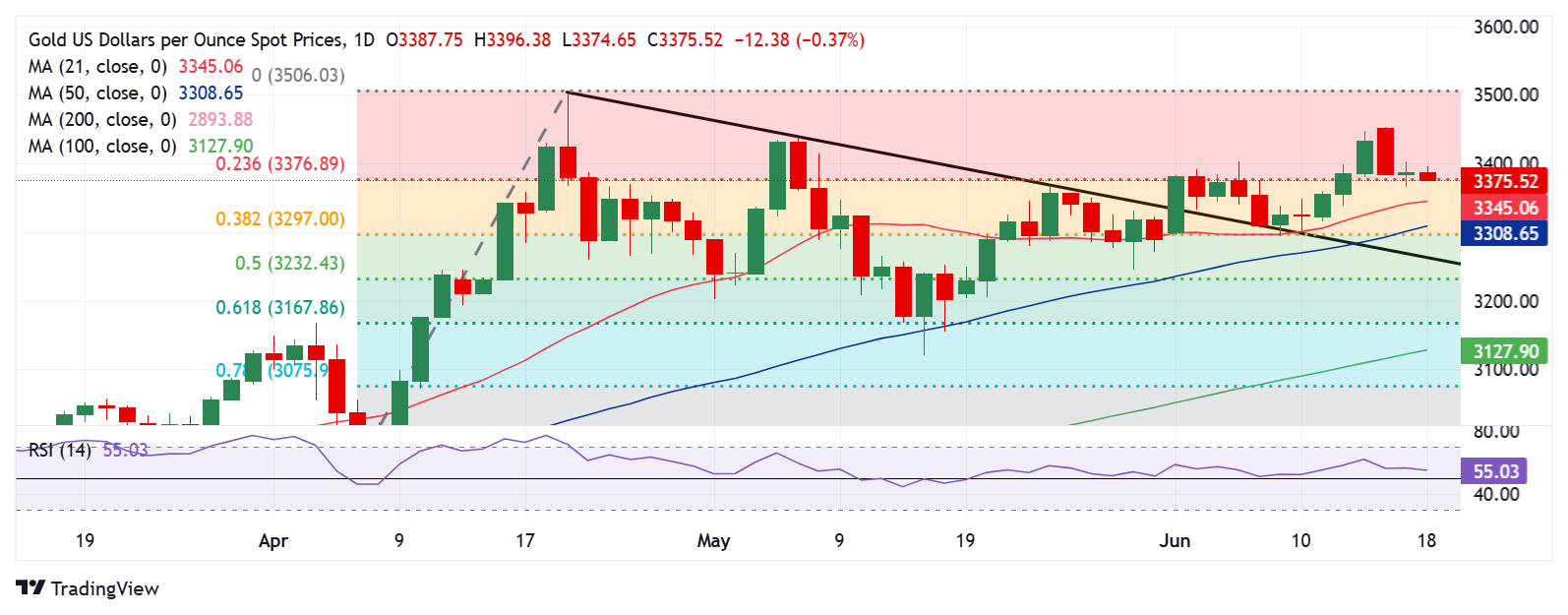- Gold price turns south again while below $3,400 early Wednesday; looks to the Fed outcome.
- US Dollar loses ground amid no signs of US military action against Iran. Risk sentiment stabilizes.
- The Fed policy announcements are set to inject intense volatility around Gold price.
Gold price is back in the red early Wednesday, moving away from the $3,400 threshold amid stabilizing risk sentiment. All eyes now remain on the US Federal Reserve (Fed) policy announcements amid lingering Israel-Iran geopolitical tensions.
Gold price down but not out as Fed looms
Despite a fresh US Dollar (USD) retreat, Gold price loses ground in Asian trading on Wednesday as markets resort to repositioning ahead of the Fed interest rate decision.
Risk sentiment is also stabilizing, weighing on the haven demand for the USD and Gold price.
Investors breathe a sigh of relief amid no signs of US military action against Iran, over which they had grown increasingly worried on Tuesday, especially after US President Donald Trump called for Iran’s unconditional surrender and held an emergency National Security Council (NSC) meeting late Tuesday.
Israeli Channel 12 media outlet reportedly said on Tuesday that the US could join the war against Iran tonight.
The Greenback gathered strength on Tuesday amid a global flight to safety amid heightened trade and geopolitical uncertainties. The USD-denominated Gold price managed to hold the fort on mounting Middle East tensions.
Mixed US Retail Sales data failed to deter USD buyers as geopolitics dominated.
What to expect from the Fed interest rate decision?
Attention now turns to the all-important Fed monetary policy announcements due later in the day.
With a no-interest rate change decision fully baked in, the updated economic projections, the so-called Dot Plot chart, will be in the spotlight alongside Chairman Jerome Powell’s press conference.
Fed is likely to keep the fed funds rates steady in the range of 4.25%-4.50% on Wednesday, reiterating prudence on the policy outlook.
Therefore, the Fed’s quarterly projections on growth, inflation and potential rate cuts by year-end will hold the key to altering markets’ expectations of Fed rate cuts this year.
They continue to predict two 25 basis points (bps) rate reductions in the second half of this year, with the Fed set to resume its rate-cutting cycle from September.
In case the Fed’s policy statement or the updated forecasts show a dovish tilt, it could revive the USD downtrend, benefiting the non-yielding Gold price. The recent benign US inflation and weak labor data could prompt the Fed to soften its previous assessment.
However, the Greenback could extend its uptrend if the Fed expresses concerns over the Middle East conflict-led rising Oil prices and their impact on overall inflationary pressures. This could send the Gold price tumbling, especially if the economic projections signal less than two rate cuts by year-end.
Gold price technical analysis: Daily chart

Technically, the bullish bias remains intact for Gold price as the 14-day Relative Strength Index (RSI) holds above the midline, currently near 55.
Gold price also manages to defend the previous strong resistance now support at $3,377, the 23.6% Fibonacci Retracement (Fibo) level of the April record rally.
If the Fed outcome is read as hawkish, Gold price will need to find a strong foothold below the abovementioned support.
The next downside cushion will be aligned at the 21-day Simple Moving Average (SMA) at $3,341 once the $3,350 psychological barrier gives way.
Further south, the 50-day SMA at $3,308 will be challenged.
For a sustained move higher, acceptance above the static resistance at $3,440 is critical.
The next topside target is seen at the two-month highs of $3,453, above which the record highs of $3,500 could be challenged.
Economic Indicator
Fed Interest Rate Decision
The Federal Reserve (Fed) deliberates on monetary policy and makes a decision on interest rates at eight pre-scheduled meetings per year. It has two mandates: to keep inflation at 2%, and to maintain full employment. Its main tool for achieving this is by setting interest rates – both at which it lends to banks and banks lend to each other. If it decides to hike rates, the US Dollar (USD) tends to strengthen as it attracts more foreign capital inflows. If it cuts rates, it tends to weaken the USD as capital drains out to countries offering higher returns. If rates are left unchanged, attention turns to the tone of the Federal Open Market Committee (FOMC) statement, and whether it is hawkish (expectant of higher future interest rates), or dovish (expectant of lower future rates).
Next release:
Wed Jun 18, 2025 18:00
Frequency:
Irregular
Consensus:
4.5%
Previous:
4.5%
Source:
Federal Reserve